Plan Your Holi Festival Trip to India Top Destinations and Tips

Why Do We Celebrate Holi? A Festival of Colours and Harmony
Holi, the festival of colours, marks the victory of good over evil, the arrival of spring, and the spirit of togetherness. Rooted in ancient Hindu legends, it carries deep cultural and spiritual significance.
One story celebrates the divine love of Lord Krishna and Radha. Concerned about their contrasting skin tones, Krishna playfully coloured Radha’s face, symbolizing love beyond differences — an act that inspired Holi’s joyful traditions.
Another legend tells of Prahlad and Holika, where faith triumphed over tyranny. When Prahlad’s father, King Hiranyakashipu, tried to destroy him through his sister Holika, divine power saved Prahlad while Holika perished — symbolizing the triumph of devotion and righteousness. This event is honoured through Holika Dahan, held on the eve of Holi.
On Rangwali Holi, people across India celebrate with colours, water balloons, and sweets like gujiya and thandai. The festival breaks social barriers, spreading happiness, forgiveness, and renewal — reminding everyone that joy and love always win over darkness.
If there’s one festival that truly captures the vibrant spirit of India, it’s Holi — the Festival of Colors. Once a year, streets and villages across the country transform into a living canvas of color, music, and laughter. It’s a time when strangers become friends, boundaries blur, and joy fills the air. For travelers, celebrating Holi in India isn’t just about witnessing a festival — it’s about experiencing the heart of Indian culture in the most vivid way possible.
Beyond Religious Rigidities, Holi in India has become a celebration of togetherness — a dazzling mix of colors, culture, and contagious joy. There’s nothing quite like joining locals in the lively color-splash battles — it’s one of the most unforgettable cultural experiences a traveler can have.
But planning a trip around Holi isn’t like any ordinary vacation. With festival dates varying each year and streets packed with celebrations, timing and organization matter more than ever. From navigating busy roads to fitting festival fun into your itinerary, it takes a bit of smart preparation.
In this post, we’ll walk you through everything you need to know to plan your Holi trip to India — from the best places to celebrate and ideal travel tips to how you can make the most of this vibrant festival of colors.
When Is Holi Festival Celebrated in India?
Holi, the Festival of Colors, is celebrated according to the Hindu lunar calendar, which means its date changes every year. The festival usually falls in late February or March, depending on the full moon of the Phalguna month.
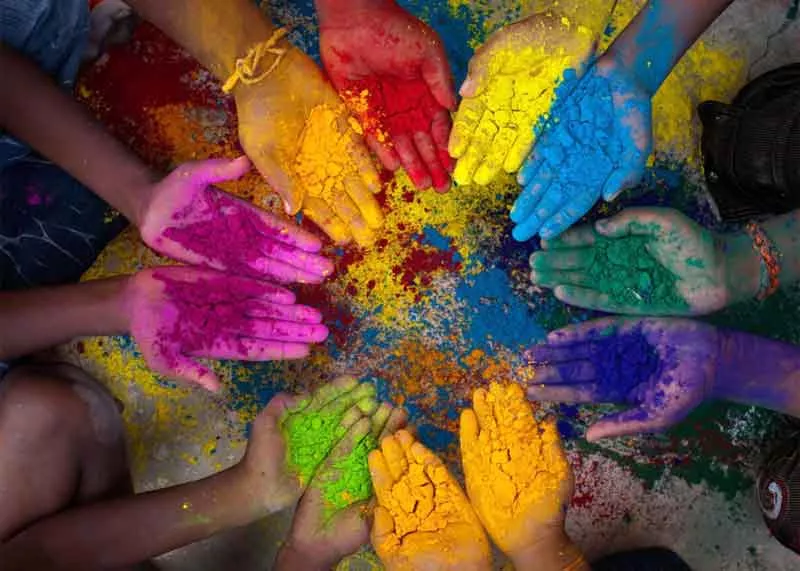
Keep in mind that while the dates below mark the main festivities, regional traditions can add several days of unique celebration! Booking your travel with these key dates in mind will ensure you're right in the heart of the colored dust and merriment:
| Year | Holika Dahan (The Bonfire Night) | Rangwali Holi (The Main Day of Colors) |
| 2026 | Tuesday, March 3 | Wednesday, March 4 |
| 2027 | Sunday, March 21 | Monday, March 22 |
| 2028 | Friday, March 10 | Saturday, March 11 |
| 2029 | Wednesday, February 28 | Thursday, March 1 |
| 2030 | Tuesday, March 19 | Wednesday, March 20 |
In most parts of India, Holi is a two-day festival. The first evening, known as Holika Dahan, features bonfires and prayers symbolizing the victory of good over evil. The next morning brings the main celebration — a riot of colors, where people joyfully throw vibrant powders, dance, and share sweets.
If you’re looking for the most authentic and energetic Holi experiences, head to Barsana, Vrindavan, or Mathura. Here, the festivities stretch over nearly 10 days, starting a week before the main event. One of the most captivating traditions is Lathmar Holi, or “the Holi of Sticks”, celebrated around 6–7 days before Holi, where women playfully hit men with sticks while everyone cheers and laughs in good spirit.
Best Places to Celebrate Holi in India
Experience the Magic of Holi Across India Holi — the festival of colours — transforms India into a canvas of joy, laughter, and togetherness. While the celebrations are vibrant across the country, North India truly steals the show with its grand traditions and infectious energy.
In Mathura and Vrindavan, the birthplace of Lord Krishna, devotion and festivity intertwine in timeless rituals. Varanasi glows with spiritual fervour along the Ganges, while Udaipur, Jaipur, and Delhi blend royal heritage with modern flair, creating unforgettable Holi experiences.
Whether you dive into the lively streets or seek a more peaceful, private celebration, one thing is certain — wherever you go, Holi will embrace you in its joyful burst of colour and spirit.
1. Mathura & Vrindavan – The Birthplace of Holi
If you want to witness Holi in its most authentic and divine form, there’s no place like Mathura and Vrindavan — the land of Krishna himself. Here, the festivities begin weeks before the main day.
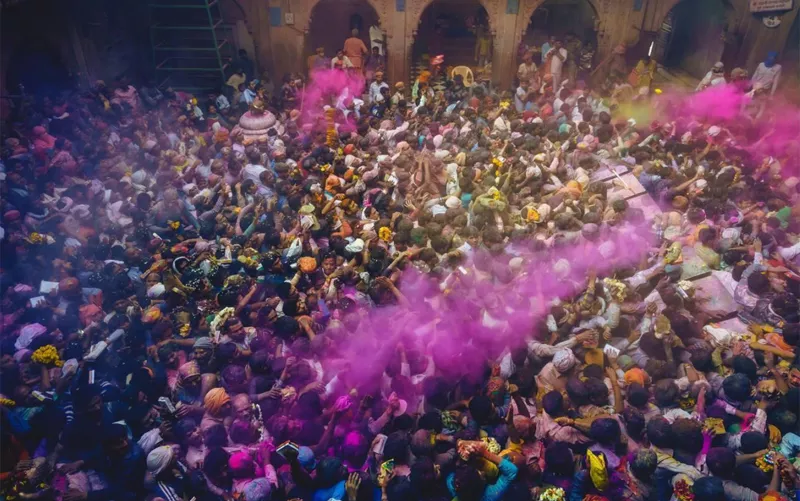
In Barsana, experience the lively Lathmar Holi, where women playfully chase men with sticks in a joyful mock battle. Then comes the enchanting Phoolon Ki Holi at the Banke Bihari Temple, where petals, not powders, fill the air with fragrance and colour.
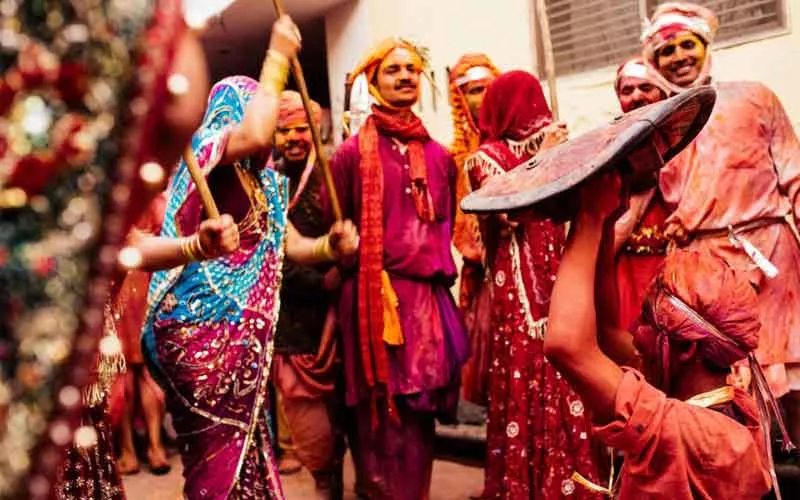
When the big day arrives, the temples of Dwarkadheesh in Mathura and Banke Bihari in Vrindavan turn into a swirl of music, devotion, and colour — a celebration that feels less like a festival and more like a spiritual awakening.
2. Varanasi: Experience the Sacred Colours of Holi
In Varanasi, Holi is where spirituality meets celebration. The ghats along the Ganges River come alive with bonfires, colours, and devotional chants, creating a magical harmony of faith and festivity. Locals follow the age-old tradition of applying herbal ubtan paste for good fortune, adding a touch of ritual purity to the revelry. Holi in Varanasi isn’t just celebrated — it’s felt in the soul.

3. Udaipur: Experience Holi Like Royalty
If you want to experience Holi with a royal twist, Udaipur is the place to be. The Mewar Royal Family hosts a stunning Holika Dahan at the City Palace, complete with a grand parade of decorated horses and elephants. The next day, the city bursts into colour at the lakeside ghats — music, laughter, and vibrant hues filling the air. Holi in Udaipur isn’t just a festival; it’s a royal celebration you’ll never forget.
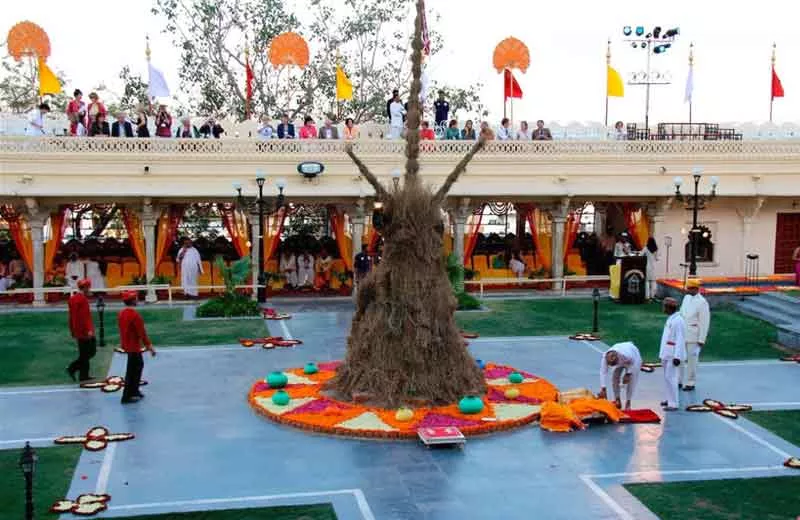
4. Holi in Jaipur: A Splash of Colour, Culture, and Royalty
In Jaipur, Holi comes alive with a perfect blend of royal elegance and modern excitement. The city turns into a splash of colour, music, and laughter. At the Dhulandi Festival held at the historic Khasa Kothi Hotel, locals and travellers come together for a safe yet joyfully spirited celebration filled with colours, dance, and traditional sweets. Meanwhile, the Govind Dev Ji Temple glows with week-long devotional festivities, echoing with chants and drums that capture the city’s spiritual heart.
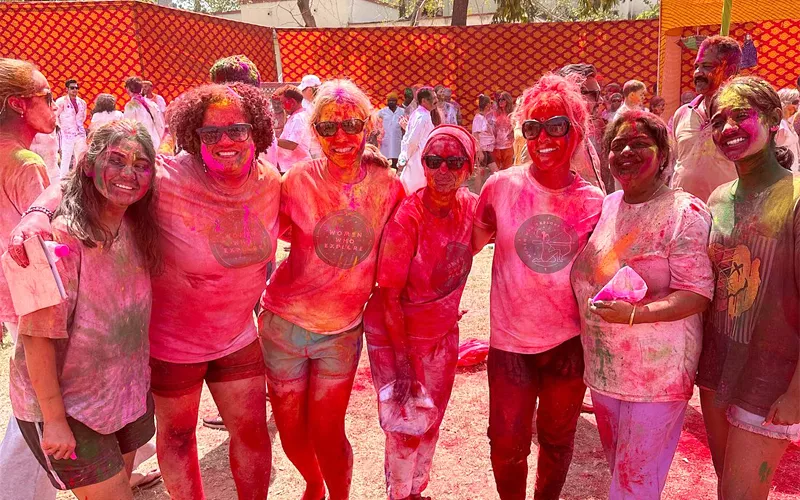
With its mix of heritage, culture, and youthful energy, Jaipur offers one of the most unforgettable Holi experiences in India — a celebration as royal as the Pink City itself.
If you’re in Jaipur during the Holi season, don’t miss the chance to celebrate it here! Experiencing Holi in Jaipur is a truly unique way to immerse yourself in the city’s vibrant culture, royal traditions, and festive spirit. Spend a day or two soaking in the colours, music, and warmth of the locals — it’s an experience that stays with you long after the colours fade.

5. Delhi: Celebrate Holi in the Heart of India
In Delhi, Holi takes on a life of its own — a vibrant fusion of tradition, music, and modern energy. From intimate family gatherings in old neighbourhoods to grand celebrations across the city, every corner bursts with colour and cheer. The iconic Holi Moo Festival is the highlight — featuring live music, organic colours, global artists, and local flavours, creating a safe yet exhilarating space for both locals and travellers. With its blend of chaos, culture, and creativity, Holi in Delhi is not just a festival — it’s an experience that captures the true spirit of India.
A Festival You’ll Never Forget
Holi in India isn’t just a festival — it’s a feeling. It’s the laughter that echoes through narrow lanes, the colours that fill the air, and the kindness of strangers who welcome you like family. Whether you join the grand celebrations in Mathura and Vrindavan, the royal festivities in Jaipur and Udaipur, or the lively parties in Delhi, every moment will leave you smiling, dancing, and drenched in colour.
So pack your whites, keep your heart open, and get ready to celebrate life the Indian way — with colour, joy, and togetherness. Holi in India is more than a trip; it’s an experience that will stay with you forever.
How Many Days Should You Spend on a Holi Trip?
Holi celebrations in India typically unfold over two main days — the first evening for Holika Dahan, when bonfires light up to mark the victory of good over evil, and the next day for Rangwali Holi, a joyful explosion of colours, music, and celebration.
If you’re planning your Holi adventure, here’s how to make the most of your stay depending on your travel style:
For a Short Holi Trip (3 Days)
A 3-day itinerary is perfect for travellers short on time but eager to experience the festive spirit.
- Day 1: Arrive, settle in, and explore major attractions like Amber Fort or the City Palace in Jaipur.
- Day 2: Witness the Holika Dahan ceremony in the evening — a magical mix of rituals, fire, and community spirit.
- Day 3: Join the Rangwali Holi celebrations with locals — play with colours, enjoy folk music, and savour traditional sweets. (Avoid long-distance travel this day as festivities often affect transport.)
For a Complete Cultural Experience (8–10 Days)
If you want to experience Holi’s diverse traditions and regional flavours, this 8–10 day itinerary blends culture, history, and celebration — taking you through North India’s most iconic destinations.
- Days 1–2: Arrive in Delhi, explore the city’s heritage sites like Humayun’s Tomb, India Gate, and Old Delhi’s Chandni Chowk. Then, travel to Vrindavan.
- Days 3–4: Experience Lathmar Holi in Barsana and Vrindavan, where women playfully tap men with sticks and colours fill the air. Afterward, head to Agra.
- Day 5: Visit the stunning Taj Mahal and Agra Fort, then continue your journey to Jaipur.
- Days 6–7: Explore Jaipur’s royal palaces and forts, and enjoy the city’s Dhulandi festivities — a colourful, royal-style Holi celebration. Later, travel back to Delhi.
- Days 8–10: Fly or take a train to Varanasi, where you’ll witness Holi on the ghats of the Ganges — a sacred and serene experience that blends devotion with festivity. Spend your final day exploring the spiritual heart of India before your departure.
Holi Safety Tips: Celebrate Smart and Stay Safe
Holi is full of joy and colour, but being prepared ensures you have a safe and happy experience. Here are a few simple tips to keep in mind:
- Start Early: Mornings are calmer, giving you time to enjoy before the crowds grow intense.
- Go With a Group: Celebrate with friends or a local guide, especially in busy areas like Mathura and Vrindavan.
- Dress Modestly: Long sleeves and comfortable clothes help you blend in and feel at ease, especially for female travellers.
- Be Careful With Bhang: Traditional drinks like bhang thandai can be intoxicating — enjoy in moderation.
- Mind Your Health: If you have allergies or asthma, use organic colours or join smaller gatherings instead.
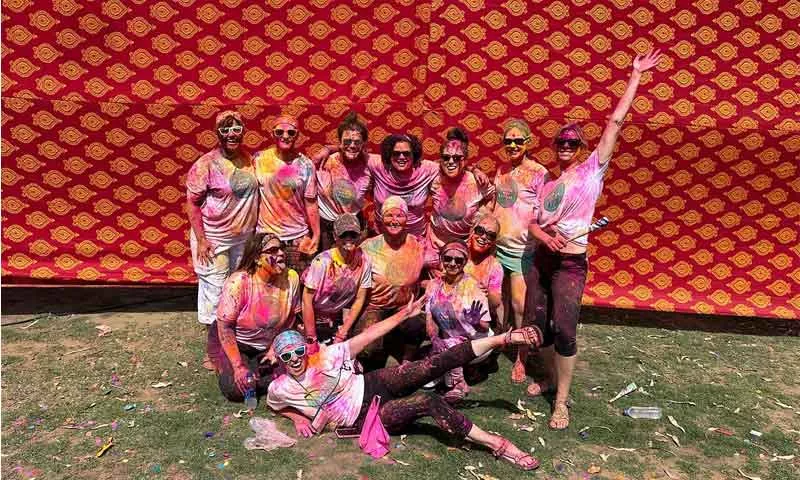
Packing Tips for Holi and Spring Travel in India
March brings pleasant weather across North India, with temperatures ranging from 16°C to 30°C (61°F–86°F) — perfect for outdoor fun!
Pack smart to stay comfortable and protected:
- Lightweight clothes for the day, plus a jacket or sweater for cooler evenings.
- Old clothes for Holi that you don’t mind getting stained.
- A hat, sunglasses, and long sleeves to shield from colours and sun.
- Apply coconut oil to your skin and hair before playing — it makes washing off colours much easier.
Bonus Tip: Make It a Cultural Journey
If you have extra days, turn your Holi trip into a journey through India’s rich culture. After celebrating in your chosen city, explore more of India’s incredible diversity — from the palaces of Rajasthan and spiritual ghats of Varanasi, to the bustling bazaars of Delhi.
Each destination adds a new hue to your Holi adventure — revealing India’s many stories, flavours, and traditions. It’s a journey that lets you not just witness Holi, but truly feel the heart of India.
Final Travel Inspiration
Holi in India is more than a festival — it’s a celebration of life, love, and togetherness. It’s laughter echoing through narrow streets, colours filling the sky, and kindness shared by strangers.
Whether you’re dancing in Vrindavan, celebrating with royalty in Jaipur, or soaking in the serenity of Varanasi, Holi will touch your heart in ways words can’t describe.
So come with an open spirit, embrace the chaos, and let India paint your memories in every shade of happiness. Because once you’ve experienced Holi here, you’ll never see colours the same way again.
Get in touch !
Blog Categories
Recent post




